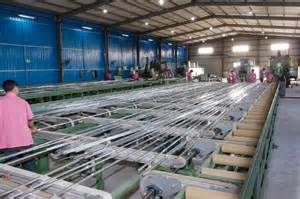SERVICES - EXTRUSION
Extrusion Process
Extrusion is the process by which long straight metal parts can be produced. The cross-sections that can be produced vary from solid round, rectangular, to L shapes, T shapes, tubes and many other different types. Extrusion is done by squeezing metal in a closed cavity through a tool, known as a die using either a mechanical or hydraulic press.
Extrusion produces compressive and shear forces in the stock. No tensile is produced, which makes high deformation possible without tearing the metal. The cavity in which the raw material is contained is lined with a wear resistant material. This can withstand the high radial loads that are created when the material is pushed the die.
Extrusions, often minimize the need for secondary machining, but are not of the same dimensional accuracy or surface finish as machined parts. However, this process can produce a wide variety of cross-sections that are hard to produce cost-effectively using other methods.


Hot Extrusion
Hot Extrusion uses heated feedstock, called a billet that ranges in temperature from 200° to 2,300° Fahrenheit, or 90° to 1,260° Celsius depending on the material.
Aluminum is the most common hot extruded material, with billet temperatures ranging from 575° to 1,100° Fahrenheit, or 300° to 600° Celsius. Hot extrusion is always performed at temperatures much higher than the recrystallization temperature of the material to be extruded. The heated billet is confined in a container, force is applied and the billet is extruded through a die or dies.
Hot extrusion is used to produce close tolerance dimensions as well as smooth, fine surfaces. Additionally, and depending on the metal used, improved microstructures are obtained. The process is also very economical in that most of the metal extruded is usable.
The primary type of hot extrusion is direct, or forward, extrusion. Direct extrusion is commonly performed in horizontal hydraulic presses. The heated billet is loaded into a thick-walled container from which it is pushed through the extrusion die by a ram. Between the ram and the billet is an intermediate dummy block.
Lubrication is used to reduce friction along the billet length and its container. In operation, force increases rapidly as the billet is upset to fill the container, then increases further as breakthrough force before extrusion begins. Upon breakthrough, the force declines as billet length decreases until a minimum force is reached. As the billet thins, the force rapidly rises again to continue metal flow radially toward the die opening.
